


Many Malagasy see their home as a continent of its own. This is thanks to the country’s unique flora and fauna, and rich, beautiful biodiversity that make it like nowehere else on earth.
Madagascar is unique. In the 88 million years since the island broke away from the landmasses that are now Africa and India, an extraordinary diversity of plant and animal life has evolved in isolation.
Madagascar is home to thousands of species which are 'endemic' – meaning that they evolved in Madagascar, and nowhere else. Among the more than 12,000 endemic plant species live some of the rarest and most endangered animals on earth – from the carnivorous fossa to the 104 species of lemur from which it takes its prey.
This biodiversity is vital to the 30 million people who live in Madagascar – of whom an estimated 70% depend on the island's natural resources for their livelihoods. It is also a critical ecological and scientific resource, and a wonder of the world.
Evolving in isolation
88 million years of separations has created a unique ecosystem, where over 80% of the island’s plant species are only found on Madagascar, including many of its 3,000 orchids.
Approximately 12,000 species of plant are endemic to Madagascar
Madagascar is home to 104 endemic species and sub-species of lemurs
Around 90% of Madagascar's original forest is thought to have been destroyed through human activity
As part of our commitment to conservation through information, we’re using GPS mapping to record Madagascar’s unique biodiversity
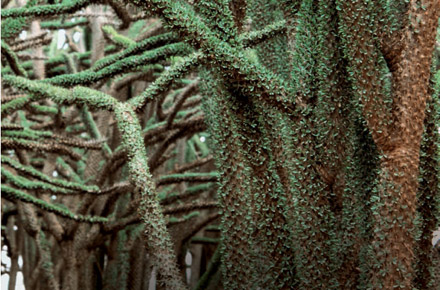
Understanding the environment's biodiversity is a crucial first step towards protecting it. Creating accurate individual farm and community maps is an important element of our Sustainable Sourcing programme, and helps farmers identify areas of sensitive biodiversity as well as monitor data on vanilla cultivation. The maps are initially drawn up by farmers, then verified by Symrise’s internal controllers using GPS. These maps are often the first time farmers get an accurate picture of their land holding.
Among the more than 12,000 endemic plant species live some of the rarest and most endangered animals on earth – from the carnivorous fossa to the 104 species of lemur that the fossa calls prey.

The silky sifaka is a lemur – a family of primates found only on Madagascar. Around 65 million years before humans discovered the island, the ancestors of all Madagascar's lemurs are thought to have arrived on rafts of matted vegetation that drifted from Africa. There are now thought to be 104 species of lemur in Madagascar – but the habitat of nearly all lemurs is under threat from deforestation and climate change.
The silky sifaka is characterized by its long, silky white fur, although some individuals also have silver-gray or black tints on their heads, back and limbs. It is only found in the north-eastern area of Madagascar, and is known locally as a simpona. Silky sifakas live in groups of two to nine, and are one of the rarest mammals on earth.
Silky sifaka are one of 11 species of lemur found in Marojejy National Park, which is in the SAVA region where Symrise operates. The International Union for the Conservation of Nature listed 94% of lemur species as vulnerable, endangered, or critically endangered in 2013.
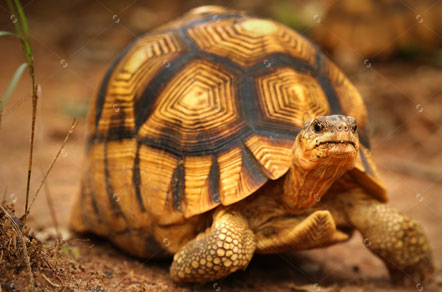
The golden-domed ploughshare tortoise lives at a single remote site in Madagascar. Because of illegal poaching, it is thought to be the most threatened tortoise on the planet. Also known as the angonoka tortoise – the Malagasy word for the species – there are only thought to be around 600 of the tortoises in the wild, meaning the risk of extinction within the next 10 to 15 years is very real.
The grandidier baobab is the largest of the six baobabs endemic to Madagascar, growing up to 30m, with cylindrical trunks that can reach 3m in width. The Grandidier's fruit is a rich source of vitamin C, its seeds produce cooking oil and its bark can be used to make ropes. It is listed as endangered by the International Union for the Conservation of Nature.
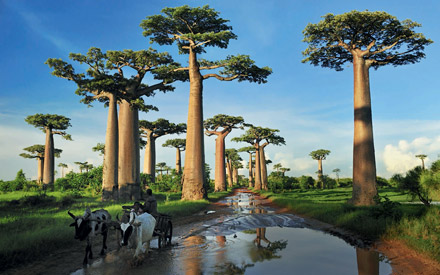
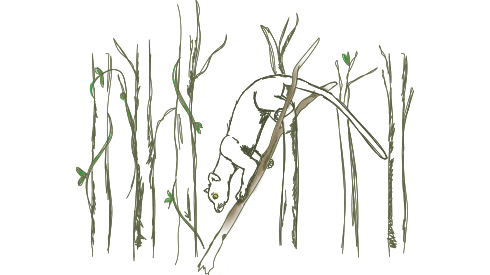
The fossa, or cryptoprocta ferox, is Madagascar's largest mammalian predator and the only known species whose main prey is a primate. Fossa, which can grow to 1.5m in length and weigh up to 9kg, are highly adapted to the forest, where they use their semi-retractable claws and flexible ankles to climb trees in their hunt for lemur and other prey.
The fossa is threatened by the destruction of Madagascar's forest habitat – each adult male requires a home range of 20km2 in which to hunt. The fossa is listed as vulnerable by the International Union for the Conservation of Nature.
Small but mighty
It may be a tiny island but Madagascar is one of the world’s greatest natural resources. Its degradation threatens to destroy this resource – and the livelihoods of the people who share it.
Madagascar is home to 5% of the world’s biodiversity
new species discovered on Madagascar between 1999 and 2010
Madagascar is one of just 35 biodiversity hotspots on earth
For such a small place, Madagascar more than punches above its weight when it comes to biodiversity. It’s one of just 35 biodiversity hotspots in the world, which together are home to more than 50% of plant species and 43% of animal species.
For the people of Madagascar, biodiversity is a vital part of their identity, culture, and economy.
Malagasy have long relied on the biodiversity of their island to provide their living. In a country where per capita income is around $505 per year, subsistence farming supports around 80% of the population.
This makes many millions of people entirely reliant on 'natural capital', and Malagasy may use hundreds of species of plants and animals for food, shelter, firewood, fibre, resins, and construction. They also depend on nature to cure them or keep them well, using more than 2,300 species of plant as traditional medicines.
While the island's biodiversity is essential for livelihoods now, it is also arguably Madagascar's greatest potential asset; both through the sustainable use of resources and through eco-tourism.
A critical resource for nature, humanity, and our business, Madagascar’s unique biodiversity in under threat by human activity.
Humanity has a strong vested interest in the preservation of Madagascar's biodiversity. Around 90% of human diseases known to medical science can be treated with prescription drugs derived from nature, and the wealth of species in Madagascar is a rich resource for biomedical research. Beyond the direct application of specific species, biodiversity increases the earth's resilience, both by diminishing the impacts of climate change, and increasing the capacity of an ecosystem to respond to change. As a business, we depend on biodiversity too; it supports the raw materials we need from nature, and provides us with new opportunities to create flavours or fragrances for our customers.
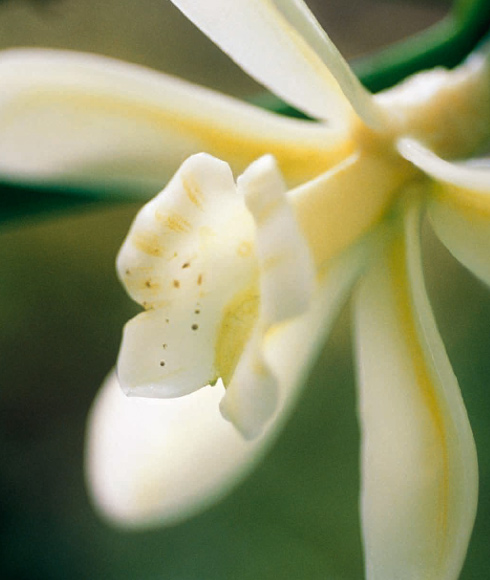
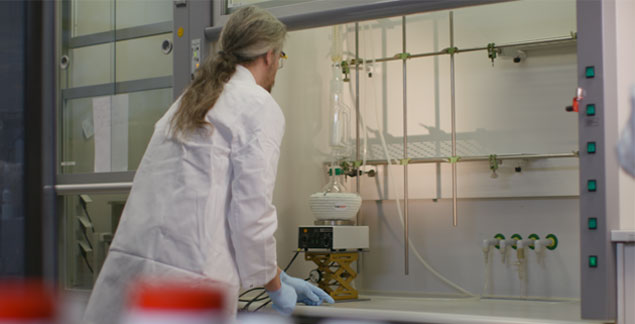
Biological diversity helps secure the long-term success of the company, as we depend on natural raw materials. Intact ecosystems and the diversity of nature are an irreplaceable source of raw materials and inspiration for flavors, fragrances, cosmetic and functional ingredients.
Beyond the direct application of specific species, biodiversity increases the earth's resilience, both by diminishing the impacts of climate change, and increasing the capacity of an ecosystem to respond to change. As a business, we depend on biodiversity too; it supports the raw materials we need from nature, and provides us with new opportunities to create flavours or fragrances for our customers.
A critical resource for nature, humanity, and our business.
Humanity has a strong vested interest in the preservation of Madagascar's biodiversity. Around 90% of human diseases known to medical science can be treated with prescription drugs derived from nature, and the wealth of species in Madagascar is a rich resource for biomedical research.
Beyond the direct application of specific species, biodiversity increases the earth's resilience, both by diminishing the impacts of climate change, and increasing the capacity of an ecosystem to respond to change. As a business, we depend on biodiversity too - it supports the raw materials we need from nature, and provides us with new opportunities to create flavours or fragrances for our customers.
Intact ecosystems and the diversity of nature are an irreplaceable source of raw materials and inspiration for flavors, fragrances, cosmetic and functional ingredients.
Despite the precious and irreplaceable value of Madagascar's biodiversity, it faces many threats because of human activity, much of it driven by poverty and insecurity.
Slash-and-burn farming, fuel wood use, soil erosion, hunting and illegal logging all pose serious threats to the island's species and to its future fertility and productivity
'Tavy', a traditional form of slash and burn agriculture, means large swathes of the island's biodiverse surface are burnt every year to clear space for planting.
The soil exposed by tavy, and stripped of nutrients by farming, becomes highly vulnerable to erosion. Poverty and uncertainty are major drivers of these threats, forcing farmers to adopt short-term practices to survive, despite the long-term damage practices like tavy may cause.
Heavy dependence on rice as a staple in the diet creates pressure to clear forest to plant it, while a weak infrastructure in the country means farmers are reluctant to conserve forest which someone else might exploit. Farmers also lack training about the impact of tavy and other practices on the soil.
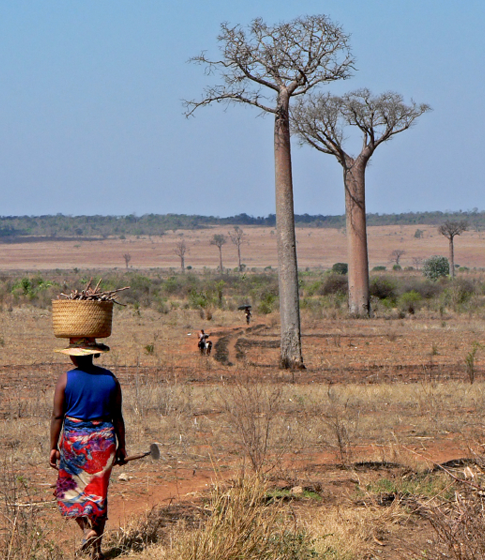
Tavy is the Malagasy term for a form of slash-and-burn agriculture that has been practised in Madagascar for generations. Farmers set fires in the forest to create space and release nutrients for crops, particularly rice. Traditionally, farmers cleared subsistence patches within the intact forest and, once they had harvested, left the soil fallow to recover.
More recently, population pressures and the shrinking of the forest have driven the farmers to clear larger areas and maximise their rice production. The soil is rapidly exhausted, and in the absence of living trees and decaying plant matter, cannot recover, making it vulnerable to erosion.
The scale of erosion of Madagascar’s bright red topsoils is vividly pictured from space – from where the island’s river deltas appear to be bleeding into the sea. Annual soil losses approach 112 tons per acre (250 metric tons per hectare) in some regions of the island, the largest amount recorded anywhere in the world.
Supporting Madagascar's biodiversity is an essential part of our ambition to build shared value with vanilla farmers. Our focus is not just on yields and security of supply, but also on addressing the drivers of deforestation through training, incomes and livelihoods.
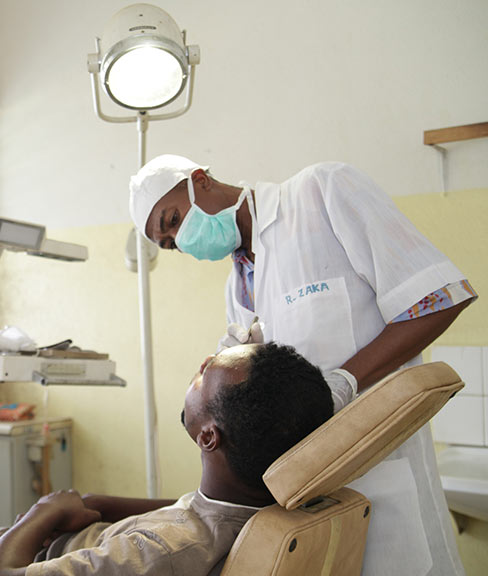
How we can help: making a difference to biodiversity and communities
The best way to meet this challenge is, we believe, through partnerships. We work closely with the farmers themselves, both on introducing sustainable cultivation methods and achieving accreditations, and through programmes that aim to enhance their livelihoods and so reduce the pressures that lead to unsustainable practices, including deforestation. This work includes our programmes with schools and colleges, and our health insurance scheme, which are both designed to strengthen the communities in which the farmers live.
It also includes our rice credit scheme, which enables farmers to have access to rice during seasons when they might previously have been forced to sell their vanilla harvest cheaply in advance. We also work with the farmers on a range of diversification projects, so that they are not solely reliant on vanilla for their livelihoods. These projects, which include nursery planting and the cultivation of other cash crops such as cocoa, pepper or vetiver, aim to reduce the pressure on the forest.
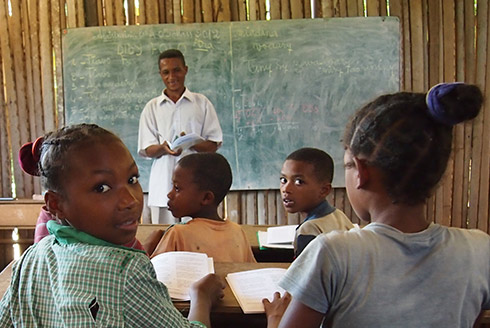
To deliver these programmes, we develop our partnership approach more widely – to include groups such as farmers' cooperatives, local and international NGOs such as WCS, Madagascar National Parks, the Union for Ethical BioTrade, Bondy and others.

“Our holistic approach to Sustainability with farmers, including crop diversification, positive social and environmental aspect, helps to build a long-term relationship with each individual farmer who really know Symrise as a trustable local actor rather than an industrial global giant. This close bond fueled through daily contact between ourselves and the farmers, is what helps us to receive good quality vanilla from our partner farmers in a competitive and complex market. For me, it is always a great sign when both Symrise colleagues and our farmers are smiling whenever we meet... there is trust and respect, there is also a sense of fun, I think that's what makes us different.”
Farmers plant trees all around our extraction plant to provide sustainably cultivated firewood, and another source of income for them.